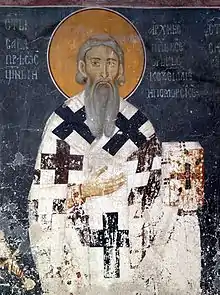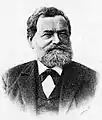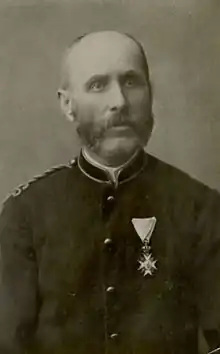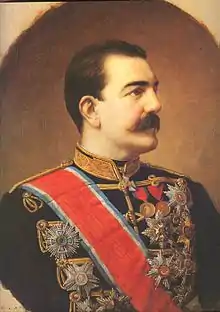List of Serbian anthems
The list of Serbian anthems includes all official and unofficial national anthems that Serbia has had throughout its history. The list also contains the national anthem dedicated to the first Serbian archbishop and founder of the autocephalous Serbian Orthodox Church, Saint Sava.
Himna Svetom Savi and Vostani Serbije are among the first (albeit unofficial) Serbian anthems. The exact date when the anthem dedicated to Saint Sava was written is not known, while the Pesma na insurekciju Serbijanov, ie Vostani Serbije, was composed in 1804 when it was sung by the Serbian educator Dositej Obradović out of a desire to welcome the outbreak of the First Serbian Uprising. However, the first official, national anthem of Serbia was Bože pravde, written by Jovan Đorđević and composed by Davorin Jenko, which is also one of the oldest anthems in the world. Bože pravde was also the official anthem of Republika Srpska (until 2008, when the anthem Moja Republika was adopted) and Republika Srpska Krajina.
In the Kingdom of Serbs, Croats and Slovenes and Kingdom of Yugoslavia that existed between 1918 and 1941, a segment of Bože pravde constituted the National Anthem of the Kingdom of Yugoslavia.
List
Anthems of Serbia
| Name of the anthem | Year | In official use | Creator/s | State | Notes |
|---|---|---|---|---|---|
1804 |
/ |
Written by: Dositej Obradović |
Unofficial national anthem. Vostani Serbije was one of the first Serbian songs of anthem character, composed just before the beginning of the First Serbian Uprising.[1] This song did not have a composition, so it was only recited at gatherings and in festive moments.[2] The song was printed in Venice in 1804 and reprinted in 1833 in Belgrade, as a supplement to Dositej's autobiography The Life and Connections of Dimitrij Obradović, and was also published in 1911 as part of Dositej's collected works. The song had seven stanzas and a refrain repeated after each stanza. The first two stanzas of the song were later given a contemporary melodic treatment in the arrangements of three Serbian composers.[3] | ||
Unknown |
1866 |
/ |
Written by: Jovan Jovanović Zmaj Composer: Kornelije Stanković |
It was planned to be the national anthem.
Prince Mihailo Obrenović aimed to give Serbia its official anthem. He entrusted the job to the then head of the Ministry of Education and Church Affairs, Ljubomir Nenadović. He sent a letter to the poet Đuro Jakšić, in 1864, with a proposal to write the verses of the first Serbian anthem. However, Jakšić did not respond to the letter. Then letters were sent to all the prominent poets of that time, but again no solution was reached. Nenadovic was then charged with bribery.[2] The following year, 1865, at the request of the government, the verses were written by Jovan Jovanović Zmaj. The composition was entrusted to Kornelije Stanković, who was dying. However, their anthem was never performed and its trace is lost.[2][4] | |
1872 |
1882—1903 1909—1918 |
Written by: Jovan Đorđević Composer: Davorin Jenko |
The first official national anthem.
It is one of the oldest anthems in the world. In addition, according to the then international authorities in the industry, it was included among the most beautiful world anthems. Namely, on the eve of the World War II, at the great international gathering of the Music Confederation, held in Paris, this Serbian anthem was declared one of the three most beautiful in the world.[5] After the assassination of Prince Mihailo, Milan Obrenović came to the throne in 1872, celebrating his coming of age. Then he ordered a play from the manager of the National Theater in Belgrade, Jovan Đorđević, who quickly wrote and presented the play Markova sablja (with the aim of glorifying Serbian history and the Obrenovic dynasty) and Bože pravde, composed by Davorin Jenko. Đorđević's song quickly gained more popularity among the people than the piece itself, and in 1882, on the occasion of Milan's enthronement as Serbian king, Đorđevoć reworked the text and so his new version became the first official anthem of Serbia.[5][6] In 1903, after the May Coup, the Obrenović dynasty died out and the Karađorđevićs came to the helm of Serbia. The new Serbian king Peter I wanted to change the state symbols, even the anthem. The Austrian composer from Vienna, August Stol, composed a song for the Serbian king. Peter did not like the composition. Various competitions in which many Serbian poets participated were also unsuccessful (Aleksa Šantić was also rejected). In the end, in 1909, it was decided to make the anthem Bože pravde official again, with minor changes to the text.[6][5][1] | ||
1860 |
1941—1944 (non-formal) |
Written by: Luka Sarić Composer: Vojtěch Šístek |
Unofficial anthem.[7] Originally called Srbiji, the song Oj Srbijo mila mati was first published in 1860 and was written by the Novi Sad poet Luka Sarić. Czech composer Vojtěch Šístek arrived to Serbia in 1887. He composed music based on the verses of Luka Sarić in 1891.[8] During the World War II, it was used as the de facto anthem of the Government of National Salvation of Milan Nedić during the German occupation of Serbia (1941-1944).[9] | ||
1872 |
2004—present |
Written by: Jovan Đorđević Composer: Davorin Jenko |
Serbia decided to renew its national symbols in 2004. This also applied to the anthem. The recommendation on the use of the coat of arms, flag and anthem of the Republic of Serbia was adopted unanimously in the National Assembly of Serbia in 2004.[10] After the separation of Montenegro from the State Union of Serbia and Montenegro, it was officially decided that the new official anthem, established by Article 7 of the Constitution of the Republic of Serbia, would become Bože pravde. Since Serbia is a republic, the adopted version of the anthem has undergone the largest change in its history, since all the verses that had a monarchist overtone were either removed or replaced.[9][1] |
Himna Svetom Savi
| Name | Year | Creator/s | Notes |
|---|---|---|---|
Himna Svetom Savi |
Unknown |
Written by: unknown Musically processed: Kornelije Stanković |
It is presumed that Pesn Svetitelju Savi arhiepiskopu serbskome, ie Himna Svetom Savi, was composed in Syrmia either at the end of the 18th century or in the period 1804–1817. The original manuscript has not been preserved, but only a transcript from 1832 brought by the Kuveždin hieromonk Silvester Vučković. According to some sources, the anthem was written and sung in Kuvežedin in the monastery church dedicated to Saint Sava and Saint Simeon. The year of its creation is even mentioned somewhere in 1735. Most likely, the writer of this anthem was a monk. The song was credited for a long time to Vasa Živković, a priest from Novi Sad. Pavle Stamatović and Jovan Grigorijević (both clergymen) are also mentioned as creators.[11]
Despite the lack of data on the creator and origin, this anthem is considered one of the oldest Serbian anthems, along with Vostani Serbije. One of the first versions of the Saint Sava's anthem, called Voskliknem ljubovlju, could be found in the collections of the Serbian historian Danilo Medaković and in the typography of the Bishop of Buda Platon Atanacković, printed in Novi Sad in the 1960s. [12] The first musical notation of the Saint Sava anthem was recorded by Kornelije Stanković, after a Saint Sava celebration in Vienna in 1858.[11] The earliest beginnings in the celebration of the life of Saint Sava in schools are related to Zemun and 1812. That is when the school fund was established, for this very purpose. That year, on January 27, Savindan (Sava's Day) was marked for the first time as a school holiday. The Saint Sava's anthem itself has undergone many changes, first with the translation from Church Slavonic into Serbian, and then with changes and additions to the verses.[13][12] |
Gallery
 Himna Svetom Savi is dedicated to Saint Sava, and is traditionally performed on Savindan in all schools in Serbia and Republika Srpska.
Himna Svetom Savi is dedicated to Saint Sava, and is traditionally performed on Savindan in all schools in Serbia and Republika Srpska.
 The end of Markova sablja. The original version of the words of the song, later became the Serbian national anthem Bože pravde.
The end of Markova sablja. The original version of the words of the song, later became the Serbian national anthem Bože pravde. Jovan Đorđević wrote the text for today's anthem of Serbia.
Jovan Đorđević wrote the text for today's anthem of Serbia. Davorin Jenko composed the music for today's anthem of Serbia.
Davorin Jenko composed the music for today's anthem of Serbia. The first modern king of Serbia, Milan Obrenović. During his rule, Serbia received the official national anthem for the first time.
The first modern king of Serbia, Milan Obrenović. During his rule, Serbia received the official national anthem for the first time. Kornelije Stanković was one of the most famous Serbian composers of the 19th century. He musically arranged Himna Svetom Savi, and before his death he composed the never performed anthem of the Principality of Serbia.
Kornelije Stanković was one of the most famous Serbian composers of the 19th century. He musically arranged Himna Svetom Savi, and before his death he composed the never performed anthem of the Principality of Serbia.
See also
References
- "Srpske himne – od "Vostani Serbie" do "Bože pravde"". 381info.com (in Serbian). Retrieved 2021-03-24.
- "Kako je izgubljena prva srpska himna? | Bilo jednom u Beogradu". 011info - najbolji vodič kroz Beograd (in Serbian). Retrieved 2021-03-24.
- "SLAVNA DOSITEJEVA BUDNICA "VOSTANI SERBIJE" – Ravnoplov". Retrieved 2021-03-24.
- "SVE SRPSKE HIMNE: Uz njih su Srbi ginuli za slobodu, pevali i kad su pobede slavili! (VIDEO)". Telegraf.rs (in Serbian). 24 January 2015. Retrieved 2021-03-24.
- Jovanović, Nenad M. (2010). Grbovi, zastave i himne u istoriji Srbije. Belgrade-Cetinje. p. 132.
{{cite book}}: CS1 maint: location missing publisher (link) - Софија (2016-03-04). "SVE SRPSKE HIMNE: Svečene pesme koje su izraz patriotskih, nacionalnih i religijskih emocija". Opanak.rs. Retrieved 2021-03-24.
- inbox-online.com. "Nacionalni mit i domaći film". Novi Polis (in Serbian). Retrieved 2021-03-24.
- Златановић, Дејан (2016-03-04). "Уз предивну песму, Ој Србијо, мила мати, желимо вам пријатну ноћ". СРБИН.инфо (in Serbian). Retrieved 2021-03-24.
- Jovanović, Nenad M. (2010). Grbovi, zastave i himne u istoriji Srbije. Beograd: Svetigora. pp. 132–140. ISBN 978-86-6155-000-3.
- "Narodna skupština Republike Srbije | Aktivnosti Narodne skupštine". www.parlament.gov.rs. Retrieved 2021-03-24.
- "Химна Светом Сави". hramsvetogsave.rs. Retrieved 2021-03-24.
- "Šta znamo, a šta ne o Himni Svetom Savi". Avant Art Magazin. 2019-01-26. Retrieved 2021-03-24.
- "Savindan: Kako smo počeli da "uskličemo s ljubavlju svetitelju Savi" (1) | Bilo jednom u Beogradu". 011info - najbolji vodič kroz Beograd (in Serbian). Retrieved 2021-03-24.